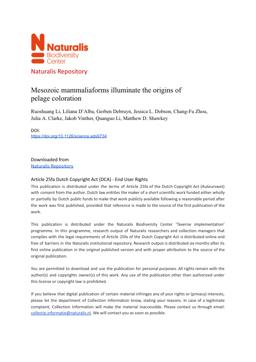2025-03-14
Mesozoic mammaliaforms illuminate the origins of pelage coloration
Publication
Publication
Science , Volume 387 - Issue 6739 p. 1193- 1198
Pelage coloration, which serves numerous functions, is crucial to the evolution of behavior, physiology, and habitat preferences of mammals. However, little is known about the coloration of Mesozoic mammaliaforms that coevolved with dinosaurs. In this study, we used a dataset of melanosome (melanin-containing organelle) morphology and quantitatively measured hair colors from 116 extant mammals to reliably reconstruct the coloration of six Mesozoic mammaliaforms, including a previously undescribed euharamiyidan. Unlike the highly diverse melanosomes discovered in feathered dinosaurs, hairs in six mammaliaforms of different lineages and diverse ecomorphotypes showed uniform melanosome geometry, corresponding to dark-brown coloration consistent with crypsis and nocturnality. Our results suggest that the melanosome variation and color expansion seen in extant mammals may have occurred during their rapid radiation and diversification after the Cretaceous-Paleogene extinction.
| Additional Metadata | |
|---|---|
| doi.org/10.1126/science.ads9734 | |
| Science | |
| Organisation | Staff publications |
|
Li, Ruoshuang, D'Alba, L., Debruyn, Gerben, Dobson, Jessica L., Zhou, Chang-Fu, Clarke, Julia A., … Shawkey, Matthew D. (2025). Mesozoic mammaliaforms illuminate the origins of pelage coloration. Science, 387(6739), 1193–1198. doi:10.1126/science.ads9734 |
|
